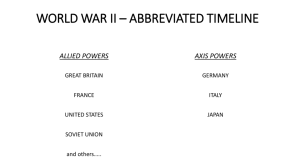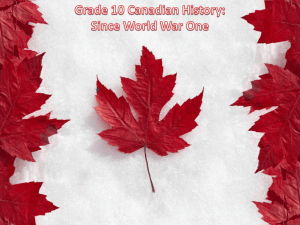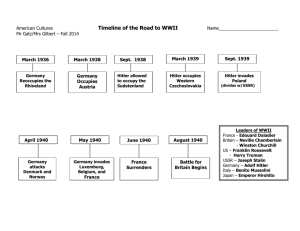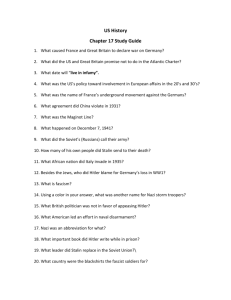World War II: The Road to War
advertisement
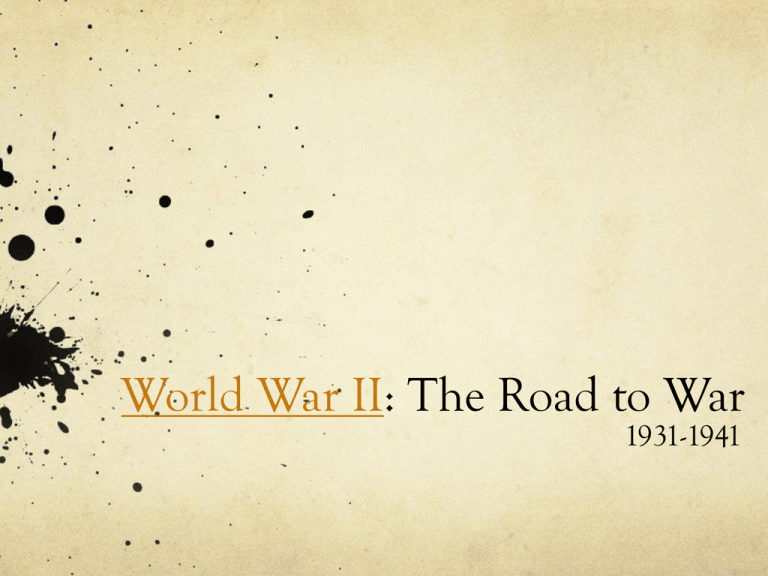
World War II: The Road to War 1931-1941 The Rise of Dictators Main Idea: Dictators in the Soviet Union, Italy, Germany and Spain formed brutal, repressive governments in the 1920s and 30s. They were motivated by their political beliefs and a desire for power. Totalitarianism- Government that exerts total control over a nation. Fascism- A philosophy that emphasizes the importance of the nation or an ethnic group and the supreme authority of the leader. Benito Mussolini Wounded serving in WWI (along with Hitler) Italian Politician and Prime Minister?! Leader (Il Duce) of the National Fascist Party Opposed Treaty of Versailles (like Hitler, but for different reasons) Thought Italy should have been granted more land Vowed to end Italy’s economic problems (Like Hitler with Germany) Destroyed all political opposition through his secret police, outlawed labor strikes and transformed the nation into a one-party dictatorship. Succeeded in creating a fascist, totalitarian state (like Hitler) Adolf Hitler 1919, joined the National Socialist German Workers Party/ NAZI party (followed fascism). 1923, with more than 3,000 followers tried to overthrown the German government with a series of riots sent to prison. Wrote Mein Kampf, which outlined NAZI philosophy and outlined his plans for the nation. According to the book, Germany had been weakened by groups living in Germany (Jews). Depression hits Germany in the 1930s. Hitler and Nazi Party promised to stabilize and restore Germany’s economy. Become Chancellor of (1933-1945) and then Führer (President/Dictator of Nazi Germany 1934-45) when Hindenburg dies. By 1936, the depression ends in Germany. Their main goal becomes the conquest of Eastern Europe and the Soviet Union. Germany continues to expand their forces (violation of Versailles Treaty) Joseph Stalin Based his totalitarian government on a vicious form of communism (lacks respect for individual rights and freedoms, much like totalitarianism). Historically, communists and fascists have been fierce enemies. Prior to Stalin, Lenin led the Soviet Union. Lenin died in 1924, causing Stalin to step in with new plans. Stalin “modernized agriculture” by making Soviet farmers combine their small farms and turn them over to the state. In the Ukraine, Stalin punished resistant farmers by confiscating their crops. Millions died from starvation, agricultural production plummeted. Stalin sent the Soviet Union into a severe shortage of essential products. The Standard of Living declines but by 1940, Stalin achieves his goal of returning the USSR into a modern industrial power. “Series of Purges” (Removing undesirables/enemies from power) Purified communist party Arrested millions (ended in executions and labor camps) Governmental Terms Fascism- emphasized the importance of one nation and the supreme authority of the leader (i.e Germany and Italy). NAZI- National Socialist German Workers Party NAZI Government- One form of fascism that preached German national and racial superiority. Dictatorship- A government that is controlled by one person. Totalitarian Government- Government that has total control over one nation using terror, restricted individual rights and no political opposition. In this government, the nation is more important than the individual. Communist Government- A one party system where the government controls the economy and leaves very limited rights and freedoms for individuals (i.e. U.S.S.R) Main Causes of World War II Treaty of Versailles Germany forces to accept blame for starting W.W.I Germany had to pay allies $33 billion (cost of W.W.I) Germany, Austria and Turkey had to give up land to the Allies. Italy thought they should have gotten more land than they did. Appeasement- Giving in to Hitler’s demands (Sudetenland/ ceded to Germany at Munich, 1938) in order to keep the peace in Europe. Done in part because France and Great Britain was not prepared for war. Sudetenland Main Causes of World War II Axis Aggression in European Theater Why? Revenge of the Versailles treaty. Europe (1936-1939) 1936 Rhineland re-claimed by Germany Hitler signs alliance with Mussolini 1938 German expansion (Sudetenland) 1939 Hitler invades W. Czechoslovakia (ends Chamberlain’s hope of working peacefully with Hitler/ abandons appeasement) Hitler’s non-aggression pact with Stalin Hitler invades Poland (ally of Britain and France war on Germany) Blitzkrieg “Lightning war” New German military tactic, unveiled in the invasion of Poland. Included a fast, concentrated air and land attack that took the enemy’s army by surprise. Also used in 1940 (Netherlands, Belgium, Luxembourg). Maginot Line Found along France’s border with Germany. Provided housing for troops, recreational areas, and even a/c. Underground rail lines connected its main sections. Thick concrete walls and extra-heavy artillery stood ready to fend off any invading army. Cons? Only protected the French border that faced Germany (France was open to an attack through Belgium) and guns only pointed East towards Germany (potentially useless). Dunkirk Defense and evacuation of French and allied forces in Europe in 1940. Makeshift fleet consisting mainly of tugboats, yachts, and other small private craft which carried some 340,000 soldiers across the English Channel to Great Britain. France,1940 France surrenders to Germany. Germany occupies the northern three fifths of France and the Atlantic coast southward to Spain. France adopts a policy of collaboration (cooperation). France falls to Germany, Hitler’s next target? Great Britain. Battle of Britain July 3, 1940 British initiate Operation Catapult to neutralize French navy July 10 First German bombers attack over English Channel July 19 Hitler urges Britain to make peace August 13 Eagle Day; more than 1,400 German planes attack southern England September 7 Beginning of “London Blitz” (Germany’s bombing raid on London) September 17 Hitler indefinitely postpones plans for ground invasion of England Outcomes? Considered to be a victory for Britain Main Causes of World War II Axis Aggression Pacific Theater Why? Japan needed raw materials and land for crops and perhaps wanted to seek revenge against the West. Japan takes over Korea (1905) Japan invades Manchuria, China- Japan needed coal and iron ore (and land). Manchurian Incident Japan breaks Kellogg-Briand Pact League of Nations orders that Japan end its occupation of Manchuria. Japan refuses and instead drops out of the league Japan’s invasion of China continues 1940, Japan takes over French Indochina (Vietnam and Cambodia) United States, 1930s Isolationism (focus is getting out of the Depression) Neutrality Acts Caused axis aggression 1935, banned the U.S. from providing weapons to nations at war (Repealed in 1939) 1936, banned loans to nations in war 1937, permitted (cash and carry) trade with fighting nations in nonmilitary good (Repealed in 1939) By 1938, Italy had conquered Ethiopia, Japan had invaded China, and Germany had taken Austria and Sudetenland. In 1939, Germany invades Poland (U.S. shifts further against the Axis Powers) Lend-Lease March 1941 Authorized the President to aid any nation whose defense he believed was vital to American security. Sent aid to Britain Extended lend-lease aid to the Soviets after Germany attacks (June 1941 Operation Barbarossa). By the end of the war, the U.S. had loaned or given away more than $49 billion in aid to some 40 nations. Pearl Harbor In 1940, FDR began limiting what Japan could buy from the U.S. His goal was to use the threat of further trade restrictions to stop Japan’s expansion. After Japan took control of French Indochina (1941), FDR froze Japanese financial assets in the US and cut off oil shipments. Japan still needed raw materials. October 1941, General Tojo becomes Prime Minister of Japan. FDR continues negotiations and hopes to stay out of the war. Hirohito - Japanese emperor; approved Pearl Harbor attack plan December 7, 1941- “The date which will live in infamy” In less than 2 hours, some 2,400 Americans had been killed and nearly 1,200 wounded. December 8, U.S. declares war on Japan December 11, Germany and Italy declares war on the U.S. Financing the War & Public Support Federal Spending $8.9 billion (1939) 95.2 billion (1945) Deficit Spending When spending exceeds revenue. This was approved by Congress to pay for war (59% of war cost) Taxes Raised to cover the cost of the war (41% of war cost) War Bonds Raised $186 billion War Production War Productions Board (1942) Consumer goods war goods Allocated raw materials and set priorities Office of War Mobilization Centralized Resources James F. Byrnes Presidential advisor “Ran the country, while FDR ran the war.” Managing the Economy Victory Gardens- Helped with the food supply 1943- Victory gardens produced 1/3 of U.S. vegetables Rationing- 1943, intended to have a fair distribution of food, clothing, gas, tires. Mobilizing the Armed Forces Selective Training and Service Act- Required men between the ages of 21 and 36 to register for the military. Four Freedoms Speech (given by FDR) explained what the troops would be fighting for. New diversity in the Armed Forces (300,000 Mexican Americans, 25,000 Native Americans, 350,000 womendid not serve in combat) Holocaust 1933- 1945 German Nazi directed persecution (and extermination) attempt of ALL JEWS in Europe as well as: Homosexuals, disable people, Gypsies and political opponents. Anti- Semitism: Discrimination and violence toward Jews Practiced for centuries all over Europe Many Europeans blamed the 1920-30s depression in Europe on the Jews Hitler blamed the Jews for the German defeat in W.W.I. 1933- Anti-Semitism became the official policy of the German government. First Concentration Camp opens- Dachau 1935- Jews stripped of German citizenship 1938- Jews are forced to sell businesses for fraction of value Jews expelled from public schools Kristalnacht- “Night of Broken Glass” Destroyed most synogogs in Germany 1,000s of Jews arrested Most Jewish businesses destroyed Holocaust 1942- “Final Solution” instituted: Rids Europe of all Jews Total concentration camps: approx. 1,500 Total “death camps”: 6 (all in Poland) Auschwitz killed 12,000 per day 1944- U.S. finally begins accepting a large number of Jews Saved a total of 200,000 1945- U.S. military starts liberating concentration camps Nuremburg Trails- Tried many Germans for their actions during the war, many executed. Total killed in concentration camps: approx. 6 million Jews (2/3 of all European Jews killed) approx. 6 million others 1948- Israel becomes a nation Gives Jews a homeland Angered Arab/Islamic neighbors (still angry) Fall of Germany Events November 20, 1944 Hitler abandons Rastenburg headquarters December 16 Battle of the Bulge; Germans begin counteroffensive in Ardennes December 24 Germans surround Americans at Bastogne January 16, 1945 U.S. forces freed from Bastogne February 4 Roosevelt, Churchill, and Stalin meet at Yalta Conference April 12 Roosevelt dies; Truman becomes U.S. president Fall of Germany (continued) April 16 Soviets begin offensive on Berlin April 25 U.S. and Soviet advances meet for first time April 28 Partisans execute Mussolini April 30 Hitler commits suicide May 7 Germany signs formal surrender May 8 Western Allies declare V-E (Victory in Europe) Day May 9 USSR declares Victory Day Fall of Japan March 1945 Allies begin mass bombing raids of Tokyo and other cities July 16 United States successfully tests first atomic bomb July 26 Potsdam Declaration signed August 6 United States drops atomic bomb on Hiroshima August 8 USSR enters war against Japan August 9 United States drops atomic bomb on Nagasaki USSR invades Manchuria August 15 Hirohito announces Japan’s surrender September 2 Japan signs formal surrender Japanese military shrinks; they are forbidden to even declare war again. Emperor power is reduced.

